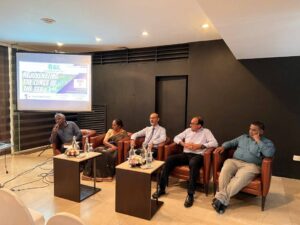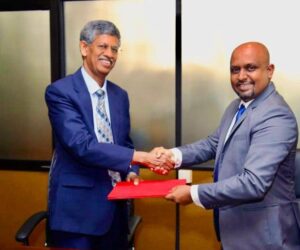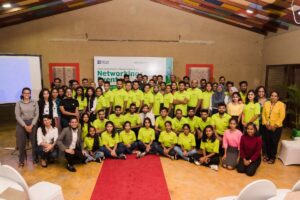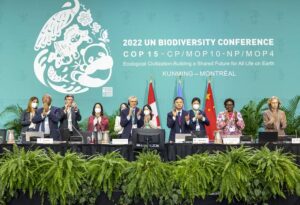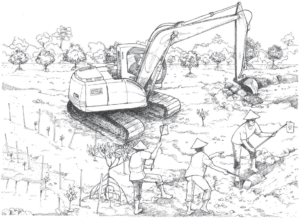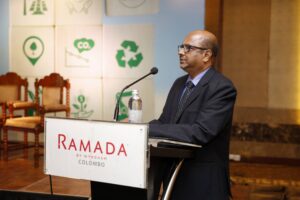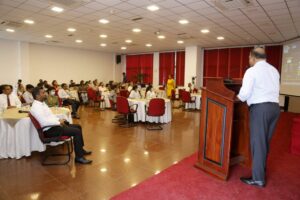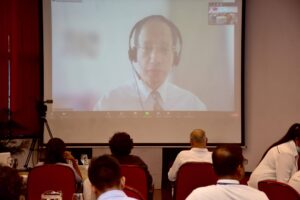BSL and IUCN shared the plan for the continuation of the LIFE Kanneliya project for a further 5 years. In the continuation phase, much of the focus will be on facilitating ecological succession. In addition, monitoring activities will be carried out to measure progress made in ecological succession. All partnering companies were invited to continue supporting the LIFE Journey to ensure that the site is a fully functional ecosystem in the long run.
Under the theme of “be a part of breathing new life into reality”, with the enthusiastic participation of over 75 members and invitees, as a part of its Annual Technical Sessions, BSL conducted an event to demonstrate successful examples of ecological restoration with particular emphasis on its LIFE – Kanneliya Project on November 2, 2022, at the Bandaranaike Centre for International Studies. This was the 3rd segment of BSL’s Annual Technical Sessions – 2022/23.
At the outset, Mr. Mahesh Nanayakkara, Director of Biodiversity Sri Lanka & CEO, of Citizens Development Business Finance PLC (CDB), enlightened participants on the Value of Building Partnerships in Conservation (SDG 17). He provided some great examples from the CDB portfolio where partnerships have contributed to advancing the Bank’s conservation agenda. He reiterated the point that the LIFE partnership is unique as it consists of over 14 corporate partners some of which are competitors in the market. Renowned scientist, Dr Rohan Pethyagoda shared his story of a quarter century of experience in restoring montane forest ecosystems in Sri Lanka. A documentary video on the LIFE Project was launched at the event for the benefit of participants. Prof. Devaka Weerakoon, Technical Expert of the LIFE Project, and Naalin Perera, Project Manager, IUCN Sri Lanka eloquently presented the results of the LIFE Project’s restoration efforts.
Our LIFE Journey commenced in 2016 with fifteen private sector companies coming together with Biodiversity Sri Lanka, to restore a 12-ha patch of degraded forest land in the Kanneliya Forest Reserve, under the able guidance of the Forest Department, with technical support of the International Union for Conservation of Nature (IUCN). The current phase is now in its 5th year of implementation. The site is best described as a degraded rainforest, cleared for cultivation and subsequently abandoned resulting in the colonization by the pioneer fern species Dicranopteris linearis (Kekilla). This highly degraded patch will be restored using principles of restoration ecology to enhance its ecological functions, habitat quality, species diversity, and its capacity to provide biodiversity and ecosystem services – in a close approximation to what prevailed before it was converted to its present state. The project will develop a biodiversity credit accrual system for Sri Lanka with the objective of assigning a unit value for enhanced biodiversity and ecosystem services.
After years of astute planning, rigorous implementation, and monitoring, despite multiple challenges, the site has shown remarkable progress. At the culmination of the fourth year of field implementation, in April 2022, over 18,000 plants from 46 native species have been introduced including Hora, Wal Del, Bata Domba, Alu bo, Naa, Pelan, and Diyapara. Native shrub species of Maha bovitiya and Veraniya have emerged naturally after the systematic removal of the invasive Kekilla. Exotic species such as Alstonia have been observed alongside the native shrub species. Despite, Alstonia being invasive, it will be maintained at the site to obtain shade and to increase the soil carbon levels. Some of the naturally occurring pioneer plant species include Milla, Kekuna, Kenda, and Geduma.
Several new animal species, which were not recorded during the initial baseline study, are now on-site. The Brown shrike (Lanius cristatus), Jungle nightjar (Caprimulgus indicus), and the Ceylon frogmouth (Batrachostomus moniliger) naturally occurring in scrublands and shrub jungles, now call the site their home. Some areas have reached the second and third succession stages of forest regeneration, containing shrubs and small trees. This new succession structure attracts animal species, which play a significant role as seed dispersants. A massive total of 90 animal species have been recorded to date. This includes 4 species of land snails, 9 species of dragonflies, 14 species of butterflies, 6 amphibian species, 12 reptile species, 35 avian, and 10 mammal species.





